Related Research Articles

A pipe band is a musical ensemble consisting of pipers and drummers. The term pipes and drums, used by military pipe bands is also common.
The following is a partial timeline of the history of golf:

A royal burgh was a type of Scottish burgh which had been founded by, or subsequently granted, a royal charter. Although abolished by law in 1975, the term is still used by many former royal burghs.

The shires of Scotland, or counties of Scotland, are historic subdivisions of Scotland established in the Middle Ages and used as administrative divisions until 1975. Originally established for judicial purposes, from the 17th century they started to be used for local administration purposes as well. The areas used for judicial functions (sheriffdoms) came to diverge from the shires, which ceased to be used for local government purposes after 1975 under the Local Government (Scotland) Act 1973.

A burgh is an autonomous municipal corporation in Scotland and Northern England, usually a city, town, or toun in Scots. This type of administrative division existed from the 12th century, when King David I created the first royal burghs. Burgh status was broadly analogous to borough status, found in the rest of the United Kingdom. Following local government reorganisation in 1975, the title of "royal burgh" remains in use in many towns, but now has little more than ceremonial value.

Jedburgh is a town and former royal burgh in the Scottish Borders and the traditional county town of the historic county of Roxburghshire, the name of which was randomly chosen for Operation Jedburgh in support of the D-Day invasion.

Crail ; Scottish Gaelic: Cathair Aile) is a former royal burgh, parish and community council area in the East Neuk of Fife, Scotland.
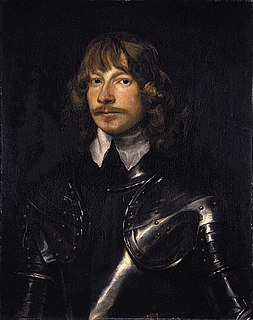
James Graham, 1st Marquess of Montrose was a Scottish nobleman, poet and soldier, lord lieutenant and later viceroy and captain general of Scotland. Montrose initially joined the Covenanters in the Wars of the Three Kingdoms, but subsequently supported King Charles I as the English Civil War developed. From 1644 to 1646, and again in 1650, he fought in the civil war in Scotland on behalf of the King. He is referred to as the Great Montrose.

The Brig o' Balgownie is a 13th-century bridge spanning the River Don in Old Aberdeen, Aberdeen, Scotland.

A common riding is an equestrian tradition mainly in the Scottish Borders in Scotland. Male and female riders ride out of the town and along its borders to commemorate the practice from 13th and 15th centuries where there were frequent raids on the Anglo-Scottish border known as the Border Reivers and also to commemorate the Scottish defeat at the Battle of Flodden. Today, the common ridings, rideouts, or riding of the marches continue to be annual events celebrated in the summer in the Borders of Scotland. Each town may have many rideouts over their festival week, usually having one on festival day. Some towns re-enact historic 'common ridings' – although many others have well-established 'festival rides' that are cemented within their town's history. The common riding towns are: Berwick-upon-Tweed, Hawick, Selkirk, Langholm, Jedburgh, Coldstream, West Linton, Lanark, Lauder, Edinburgh, Melrose, Musselburgh, Galashiels, Duns, Sanquhar, and Peebles.
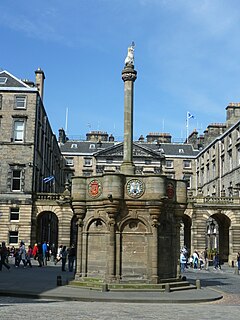
A mercat cross is the Scots name for the market cross found frequently in Scottish cities, towns and villages where historically the right to hold a regular market or fair was granted by the monarch, a bishop or a baron. It therefore served a secular purpose as a symbol of authority, and was an indication of a burgh's relative prosperity. Historically, the term dates from the period before 1707, when the Kingdom of Scotland was an independent state, but it has been applied loosely to later structures built in the traditional architectural style of crosses or structures fulfilling the function of marking a settlement's focal point. Historical documents often refer simply to "the cross" of whichever town or village is mentioned. Today, there are around 126 known examples of extant crosses in Scotland, though the number rises if later imitations are added.
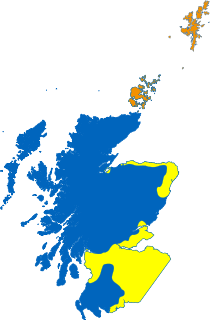
Early Scots was the emerging literary language of the Northern Middle English speaking parts of Scotland in the period before 1450. The northern forms of Middle English descended from Northumbrian Old English. During this period, speakers referred to the language as "English".
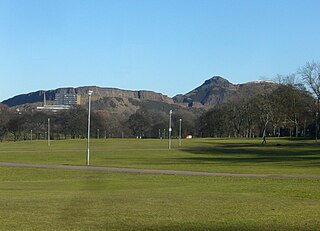
The Burgh Muir is the historic term for an extensive area of land lying to the south of Edinburgh city centre, upon which much of the southern part of the city now stands following its gradual spread and more especially its rapid expansion in the late 18th and 19th centuries. The name has been retained today in the partly anglicised form Boroughmuir for a much smaller district within Bruntsfield, vaguely defined by the presence of Boroughmuir High School, and, until 2010, Boroughmuirhead post office in its north-west corner.
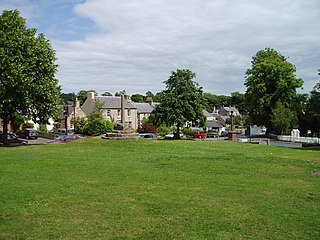
Ancrum is a village in the Borders area of Scotland, 5 km north west of Jedburgh.

Top Secret Drum Corps is a drum corps based in Basel, Switzerland. With 25 drummers and color guard section, the corps became famous for its demanding six-minute routine performed at the Royal Edinburgh Military Tattoo in 2003. With its invitation to Edinburgh, Top Secret became one of the first non-military, non-British Commonwealth acts to perform on the Esplanade at Edinburgh Castle.
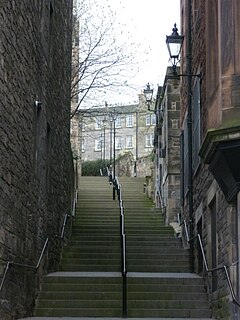
A vennel is a passageway between the gables of two buildings which can in effect be a minor street in Scotland and the north east of England, particularly in the old centre of Durham. In Scotland, the term originated in royal burghs created in the twelfth century, the word deriving from the Old French word venelle meaning "alley" or "lane". Unlike a tenement entry to private property, known as a "close", a vennel was a public way leading from a typical high street to the open ground beyond the burgage plots. The Latin form is venella, related to the English word "funnel".

A tolbooth or town house was the main municipal building of a Scottish burgh, from medieval times until the 19th century. The tolbooth usually provided a council meeting chamber, a court house and a jail. The tolbooth was one of three essential features in a Scottish burgh, along with the mercat cross and the kirk (church).
The Convention of Royal Burghs, more fully termed the Convention of the Royal Burghs of Scotland, was a representative assembly which protected the privileges and pursued the interests of Scotland’s principal trading towns, the royal burghs, from the middle of the 16th century to the second half of the 20th century. It evolved as a forum in which burgh delegates, termed "commissioners", could "consult together and take common action in matters concerning their common welfare" before and during the sittings of parliament. An exclusively merchant body, it was essentially a parliament which "declared the law of the burghs" just as the Scottish Parliament "declared the law of the land". The Convention expanded over time by admitting lesser burghs to its membership; and by the 16th century had grown in influence to the extent that "it was listened to rather than directed by the government". Though still known as the "convention of royal burghs", it referred to itself from the late 17th century onwards as simply the "convention of burghs", as by then membership was no longer restricted exclusively to royal burghs and commissioners from all types of burgh were represented in parliament.
Several Aberdeen trades hospitals were built by the merchants and trades associations of Aberdeen from the sixteenth to the nineteenth century. Traditionally hospitals had been built by the church.

On 19 August 1561, the 18-year-old Mary, Queen of Scots returned to Scotland from France. On 2 September the town of Edinburgh organised a celebration of royal entry for her.
References
- ↑ "The terms swasher, sueschoour, suescher and swash, suesche, and swesche, to mean drummer and drum respectively, are extracts from the records of the Burgh of Edinburgh, published by the Scottish Burgh Records Society covering the period 1528- 1571"—Ian Turnbull. "By Tuck of Drum" in World Military Bands, The Heritage of Military Bands, , n.d., accessed September 9, 2011.
- ↑ "It is thought that the entries in the records of Jedburgh clearly show that sivasche, or swesche, is a drum, not merely an alarm drum, but applied to the common drum of the town, for in some entries the drummer and piper are ordered to go through the burgh morning and night, and in others the word swascher is used to denote the drummer. The two words are synonymous. It will also be observed from the text that the instrument used in Jedburgh was struck ("rap of the swasche"), not sounded or blown. Mr. Pitcairn hesitates as to the meaning of the word "swascher," but if swasche be a drum, swascher must be the person who used it. All the royal burghs seem to have kept a swascher for warning the inhabitants, and the city of Edinburgh two, who appear also to have performed the additional duty of attending upon the Parliament when it met in Edinburgh"—Alexander Jeffrey. 1857. The History and Antiquities of Roxburghshire and Adjacent Districts from the Most Remote Period to the Present Time. London: J. F. Hope. Vol. II, p. 190.
- ↑ "In 1566 [in Aberdeen, Scotland], John Cowper received a pension of six merks a-year "for his service to be done to the towne in tyme cumming in playing upon the swesche [drum] als weill in tyme of war as in tyme of peace and sport, and play"—Gavin Turreff. 1859. Antiquarian gleanings from Aberdeenshire records. Aberdeen: George & Robert King. p. 68.
- ↑ "swesche (Swiss drum)..."—Agnes Strickland. 1852. Lives of the Queens of Scotland and English Princesses Connected with the Regal Succession of Great Britain. New York: Harper & Brothers, Publishers. Vol. III, p. 76.